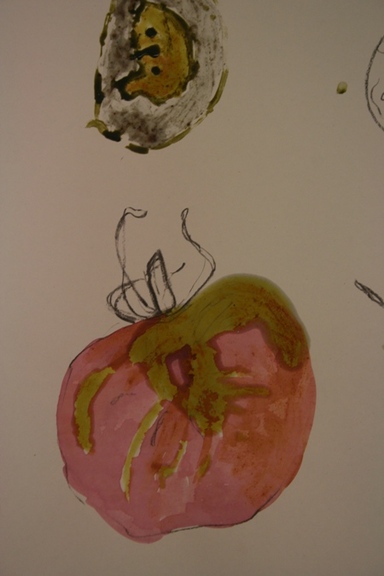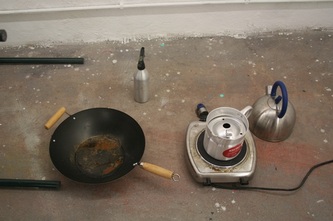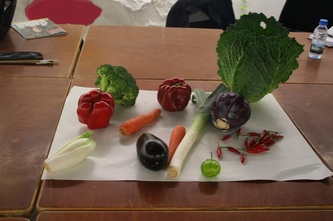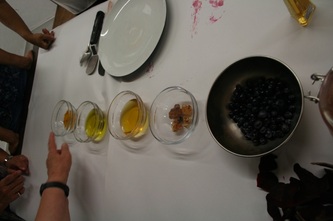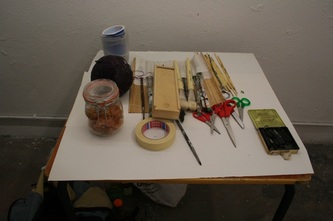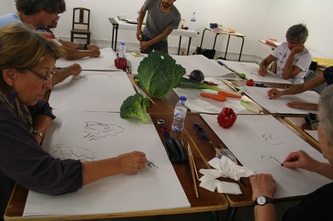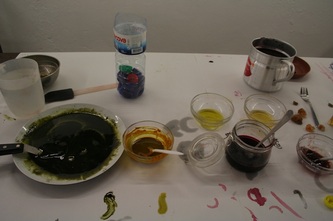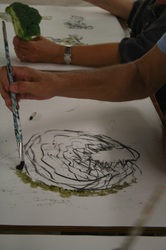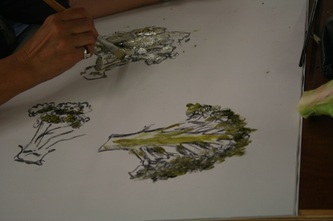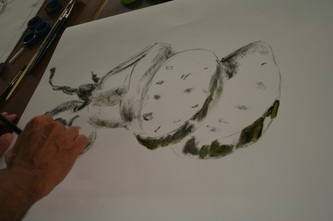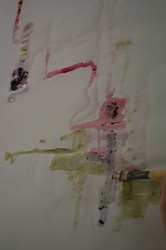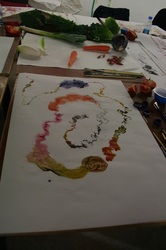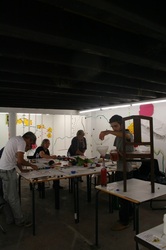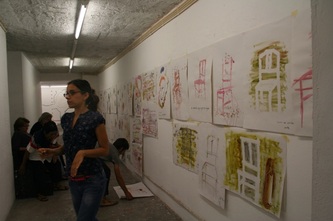_© All rigths reserved to Associação Espaços do
Desenho-Drawing Spaces. Text.Sound.Video.Images
_
hunger OF drawing II
WORKSHOP Developed in the sequence of
hunger for drawing i
Drawing Spaces, Lisbon, Portugal
17 FEBRUARY 2011
WORKSHOP Developed in the sequence of
hunger for drawing i
Drawing Spaces, Lisbon, Portugal
17 FEBRUARY 2011
REPORT 21 -
IDEAL
Intercultural Drawing for European Adult Learning
Intercultural Drawing for European Adult Learning
WHAT
This workshop aimed to encourage participants to explore drawing with mediums produced from their everyday environment, particularly ingredients which they normally used in their kitchen and cooking environments.
WHERE
Drawing Spaces, Fábrica de Braço de Prata, Lisbon, Portugal.
WHEN
18 September 2011, 19h00-23h00
WHO
Facilitators and Staff
Francisco Pinheiro
Eduardo Salavisa
Teresa Carneiro
ADULT LEARNERS
10 Female and Male adult particpants, with an age range between 20 and 43 years old.
(This workshop was open to anyone)
WHY
This workshop was part of a project which aimed to respond to the dynamics of Drawing Spaces by presenting a series of public workshops coordinated by a variety of experts in the field of drawing. These workshops took place over a period of 2 weeks, during opening hours – from Wednesday to Saturday, from 19h to 23h – following the ‘open residency’ model. This gave the public the opportunity to daily visit and accompany the development of these experimental sessions around drawing.
These series of workshops were designed to extend the public contact with artists and with the specificity of the artist’s modes of working in their personal projects. The artists were asked to develop a workshop that maximized the interaction with the public; it was proposed to the public to participate in more than one of the workshops and to observe the diversity of the artists’ approaches. In this session participants were encouraged to draw with ingredients which they could normally find in their kitchen and fridge – olive oil, honey, blackberries, beet, among others. Drawing, painting and cooking were approached in what they had much in common: the method, the improvisation, the time, the performance, and the appeal to the senses.
HOW
VALUE FOR LEARNERS
Participants learned that drawing can be a multi sensorial experience. Through the workshop, the drawing process was perceived and sensed by the participants as similar to other well known everyday methods and processes like cooking, breathing, improvising.
Participants felt very enthusiastic with the laboratorial set up for developing this activity. They were also quite amused with the possibility of doing something different with food, cooking and about learning about other possibilities of relating to these things.
Participants were extremely active in engaging and participating in all parts of the processes proposed throughout the project. They showed to be very curious and interested in the working processes, but also in collaborating in experimentation along with facilitators.
VALUE FOR THE FACILITATORS
Facilitators learned that the involvement of the participants in the workshop activities extended the reach of the project and helped create a word-of-mouth effect where learning and doing became a shared experience between facilitators and participants.
Facilitators learned how easy it was make participants relate to their daily lives through this drawing activity. As this was one of the aims of the project, the feedback and reactions of the participants was extremely rewarding for the facilitators, as it made them felt that the workshop had produced very positive results in relations to its aims.
VISUAL RECORDS
This workshop aimed to encourage participants to explore drawing with mediums produced from their everyday environment, particularly ingredients which they normally used in their kitchen and cooking environments.
WHERE
Drawing Spaces, Fábrica de Braço de Prata, Lisbon, Portugal.
WHEN
18 September 2011, 19h00-23h00
WHO
Facilitators and Staff
Francisco Pinheiro
Eduardo Salavisa
Teresa Carneiro
ADULT LEARNERS
10 Female and Male adult particpants, with an age range between 20 and 43 years old.
(This workshop was open to anyone)
WHY
This workshop was part of a project which aimed to respond to the dynamics of Drawing Spaces by presenting a series of public workshops coordinated by a variety of experts in the field of drawing. These workshops took place over a period of 2 weeks, during opening hours – from Wednesday to Saturday, from 19h to 23h – following the ‘open residency’ model. This gave the public the opportunity to daily visit and accompany the development of these experimental sessions around drawing.
These series of workshops were designed to extend the public contact with artists and with the specificity of the artist’s modes of working in their personal projects. The artists were asked to develop a workshop that maximized the interaction with the public; it was proposed to the public to participate in more than one of the workshops and to observe the diversity of the artists’ approaches. In this session participants were encouraged to draw with ingredients which they could normally find in their kitchen and fridge – olive oil, honey, blackberries, beet, among others. Drawing, painting and cooking were approached in what they had much in common: the method, the improvisation, the time, the performance, and the appeal to the senses.
HOW
- After a short introduction to the activity, facilitators helped participants start to extract elements (pigments and products that served as medium to produce inks) by cutting vegetables and fruits that were brought to the session
- Some other ingredients, such as spices, honey and olive oil were also displayed on a common working table to then produce the mediums for making the drawings
- During this part of the session, some of the food ingredients were cooked in pans using a small camping gas oven. There was also a boiler that served to heat water and some other liquids to mix the extracted pigments.
- Besides the pans and boiler, plates, spoons and other cooking tools were also available on the working table, as well as the food and the ingredients that were being prepared and cooked. The environment was similar to a small kitchen set up where everybody was collaborating and cooking together.
- As the workshop developed, Francisco Pinheiro, the artist invited to create this workshop, provided different information about the elements that could be extracted from each ingredient, ways in which they could mix together to create different inks and other possible ingredients that could be used in similar ways if participants wanted to try to investigate further on this way of working, after the workshop.
- Francisco Pinheiro also provided contextual background related to these ways of producing ink and drawing materials, by talking about different ways in which pigments had been produced in the past as well as about artists that had done more experimental work with these processes.
- Participants were very active in helping to prepare, cook, mix and try out different combinations of mediums and pigments.
- During the second part of the session, participants set around a big working space where big sheets of paper, brushes, pencils and charcoal were available for them to work.
- Plates, glasses and small bottle caps were used as recipients to place the produced inks and split them among the participants.
- Participants were then asked to draw the rest of the vegetables and fruits that had been cut up in the first part of the activity, first using pencils and charcoal, then using the inks they had produced.
- This was a very experimental exercises which allowed the participants to relate back to the food as subject, while working with part of their elements to draw and relating to food as working material. Participants were extremely engaged in this exercise.
- After participants became more comfortable with the working tools, they were asked to think about the fluidity of the working material that they were using relating to the processes of transformation in which they were engaged at the beginning of the session.
- Listening to some music helped the participants to engage more easily with this exercise. Throughout these exercise comparisons were also made between the relations of the fluidity of music and the fluidity of drawing/painting mediums. Participants contributed to this discussion by thinking on what they sensed while making this exercise.
- Then, the participants were asked to draw a very solid object – a wooden chair. But they were asked to continue to think to sense the fluidity of the object beyond its hard and solid appearance as they did on the previous exercises. Participants responded well to the project, they discussed the atoms and constitution of things in the world.
- Lastly, all drawings produced during this workshop were hanged on the long corridor walls of Drawing Spaces.
- Participants and Facilitators engaged on a very enjoyable discussion about the drawing approaches introduced in the workshop and what they might have in common with the activity of cooking: the method, the improvisation, the time, the performance, and the appeal to the senses.
VALUE FOR LEARNERS
Participants learned that drawing can be a multi sensorial experience. Through the workshop, the drawing process was perceived and sensed by the participants as similar to other well known everyday methods and processes like cooking, breathing, improvising.
Participants felt very enthusiastic with the laboratorial set up for developing this activity. They were also quite amused with the possibility of doing something different with food, cooking and about learning about other possibilities of relating to these things.
Participants were extremely active in engaging and participating in all parts of the processes proposed throughout the project. They showed to be very curious and interested in the working processes, but also in collaborating in experimentation along with facilitators.
VALUE FOR THE FACILITATORS
Facilitators learned that the involvement of the participants in the workshop activities extended the reach of the project and helped create a word-of-mouth effect where learning and doing became a shared experience between facilitators and participants.
Facilitators learned how easy it was make participants relate to their daily lives through this drawing activity. As this was one of the aims of the project, the feedback and reactions of the participants was extremely rewarding for the facilitators, as it made them felt that the workshop had produced very positive results in relations to its aims.
VISUAL RECORDS
